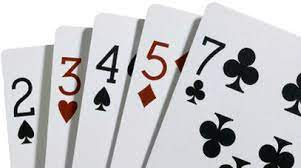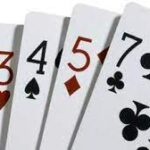Contents
The game of no-limit 2-7 single draw is spread at more online casinos these days than ever, and it’s gained a decent level of popularity because of a combination of fashion and the no-limit betting structure that players are usually already going to be familiar with. We want to give you some basic ideas to work with so that you can start off in this game already familiar with the foundation needed for success. We’re going to cover basic things like common match-ups and general strategies in this week’s column. In the future, we’re going to get a bit more in-depth and look at things like hand frequencies and how ranges break down. Let’s get started.
The Mechanics of 2-7 Lowball
The basic idea of 2-7 lowball is to get the worst possible poker hand, but aces are always held as high. So if you have 86542 with no flush and you’re up against 87432, then you’ll win because 8-6 high is a lower poker hand than 8-7 high. Along these lines, the best hand you can have is 75432 with no flush. Note that it’s not 65432 because that would be a straight. Also note that 7542A is not 7-high because the ace is always counted as a high, so you have A-high.
Along these lines, the hand 5432A is not a straight in 2-7 lowball because the ace can never be counted as a “one.” Instead, it’s just A-5 high which is a fairly poor hand in this game.
In the no-limit format, you’ll normally play six-handed or seven-handed. There are two blinds before the flop like in no-limit hold’em, and pre-flop play goes along those lines. Then you’ll have a discard or drawing round, and there is one more round of betting before showdown. The two streets are typically referred to as “pre” and “post” for pre-draw and post-draw, respectively.
Getting It All-in Pre
To begin your understanding of how hands match up in this game, we’re going to look at some common match-ups between draws and made hands. Assume that none of the hands we’re listing here are flushes unless noted. Also, if a card is listed in parentheses, that means that it’s being discarded on the draw.
- Q8432 vs. (A)8432 is about a 60/40 in favor of the draw.
- Change that to Q7432, and the made hand improves to only being a 55/45 dog.
- J9432 vs. (A)8432 is 52/48 in favor of the draw.
- Change that to J7432, and it switches to being 55/45 in favor of J-high.
- Most draws to 9-high or better against a pat 10-high are about 2:1 in favor of the pat 10.
These are the critical match-ups to know when it comes to made hands against draws before the draw. The exact equities can change a bit depending on which kickers each hand has, but these scenarios will give you the general idea.
Inferior Draws
An important idea in 2-7 single draw is the idea of the inferior draw. This is basically when you have a draw to a hand that isn’t as good as it seems because some of your outs actually give you a terrible lowball hand. For example, if you have 7543, that’s not going to be anywhere close to being as good as having 7542. With 7543, any 2 gives you the nuts, but any 6 gives you a hand that isn’t playable.
On the other hand, if you have 7542, you’ll have an exceptionally good hands with any 3 or 6, so your draw is worth a lot more. From this example, you can see that something like 5432 or any four cards 6 or lower is not nearly as strong of a draw as you might initially think. Along similar lines, having four cards to a flush really damages the value of your draw.
This is a lot like in Omaha when people overvalue hands that have three or four of the same suit even though they act as major blockers to a lot of the boards that would otherwise give you a ton of value.
General Pre-Draw Play Recommendations
At a seven-handed table, let’s call the positions UTG, MP, HJ, CO, BU, SB and BB. I’m personally a fan of always raising to 3x pre-flop and then playing accordingly post-flop. From UTG and MP, a decent beginner range for open-raising would be to raise with any pat hand T-high or better and any draw to an 8-high or better. In HJ and CO, I would extend that to include pat hands J-high or better and draws to 9-high or better. On the button and in the SB, add pat hands Q-high or better and draws to T-high or better.
When facing a raise pre-flop, you should tend to 3-bet with your strongest draws and strongest made hands most of the time. Sometimes you should just call with your strongest made hands to protect the times that you call with mediocre made hands. Calling with mediocre draws to something like 9-high or the better end of the T-high range is also going to be fine a lot of the time. However, calling raises with J-high or Q-high is going to be a bit of a stretch against normal opening ranges, and calling with a draw to T8-high or worse will usually end up with you in a lot of difficult spots.
Moving Forward
These recommendations should give you a starting point for this game. In next week’s column, we’re going to start looking at how the ranges break down in this game so that we have the information that we need to build a more informed understanding of how pre-draw ranges break down after the draw, how we should handle bluffing pat hands after the draw, and other seemingly advanced topics.
Learn More
No-Limit 2-7 Single Draw Strategy (Part 1): The Basics
No-Limit 2-7 Single Draw Strategy (Part 2): Pat Hand Combinations
No-Limit 2-7 Single Draw Strategy (Part 3): Draw Combos
No Limit 2-7 Single Draw Strategy (Part 4): Pre-Draw Overview
No-Limit 2-7 Single Draw Strategy (Part 5): Post-Draw With Draws
Leave a Comment Below!
Submit your review | |







